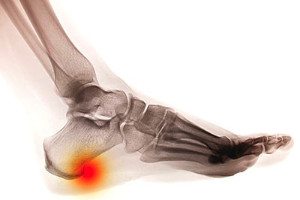
Many people have heel pain and show no other symptoms. This can indicate a heel spur has developed, and treatment is often sought for relief. A heel spur is defined as a bony growth that gradually forms on the bottom of the heel, and can come from excessive pressure the heels endure from being overweight, or if the plantar fascia becomes damaged. Wearing shoes that do not fit correctly may cause a heel spur to develop, in addition to having an abnormal foot structure. There are specific groups of people who may be prone to developing a heel spur. These can include runners, elderly people, diabetic patients, or people who have frequent gout attacks. People who have pain with a heel spur often notice there is tenderness surrounding the heel, and the affected foot and ankle may become swollen. Additionally, there may be sharp heel pain after rising in the morning. Effective prevention methods may consist of stretching the feet regularly, wearing insoles that can provide support, and maintaining a healthy weight. If you feel you have a heel spur, it is strongly urged that you consult with a podiatrist who can properly treat this condition.
Heel spurs can be incredibly painful and sometimes may make you unable to participate in physical activities. To get medical care for your heel spurs, contact Anas Khoury, DPM from North Eastern Foot & Ankle Specialists. Our doctor will do everything possible to treat your condition.
Heels Spurs
Heel spurs are formed by calcium deposits on the back of the foot where the heel is. This can also be caused by small fragments of bone breaking off one section of the foot, attaching onto the back of the foot. Heel spurs can also be bone growth on the back of the foot and may grow in the direction of the arch of the foot.
Older individuals usually suffer from heel spurs and pain sometimes intensifies with age. One of the main condition's spurs are related to is plantar fasciitis.
Pain
The pain associated with spurs is often because of weight placed on the feet. When someone is walking, their entire weight is concentrated on the feet. Bone spurs then have the tendency to affect other bones and tissues around the foot. As the pain continues, the feet will become tender and sensitive over time.
Treatments
There are many ways to treat heel spurs. If one is suffering from heel spurs in conjunction with pain, there are several methods for healing. Medication, surgery, and herbal care are some options.
If you have any questions feel free to contact our office located in Passaic, NJ . We offer the latest in diagnostic and treatment technology to meet your needs.
